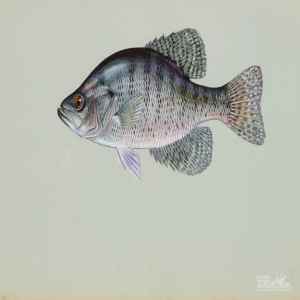 The White crappie is a freshwater fish found in North America. Other common names for it include goldring and silver perch. They have 5-10 dark vertical bars along their bodies, and a silvery color with green or brown shades along its back, with dark lateral bars along it’s side, and a white belly. The anal fin is about the same size as the 7-8 dorsal fins which end in spines. It is a deep-bodied fish with a flattened body, and it’s depth one third of it’s length. The exposed part of the scale has tiny tooth-like projections. The mouth has a terminal position with many small, conical teeth in two rows They rarely exceed 2 pounds and are about 9-10 inches in length.
The White crappie is a freshwater fish found in North America. Other common names for it include goldring and silver perch. They have 5-10 dark vertical bars along their bodies, and a silvery color with green or brown shades along its back, with dark lateral bars along it’s side, and a white belly. The anal fin is about the same size as the 7-8 dorsal fins which end in spines. It is a deep-bodied fish with a flattened body, and it’s depth one third of it’s length. The exposed part of the scale has tiny tooth-like projections. The mouth has a terminal position with many small, conical teeth in two rows They rarely exceed 2 pounds and are about 9-10 inches in length.
Location: AE
Share:
Range
White crappies are native to the Great Lakes, Hudson Bay and the Mississippi River basins expanding from New York and southern Ontario westward to South Dakota and southward to Texas.
Habitat
White crappies can be found in more slow-moving large rivers, reservoirs, and lakes. They are tolerant of murky waters but most abundant in lakes and reservoirs larger than 5 acres.
Conservation Status
Least Concern
Primary Threats
Gestation
Females lay 5,000 to 30,000 eggs.
Litter
Females lay 5,000 to 30,000 eggs.
Behavior
Crappies swim intermittently and only search for prey when stationary. Juveniles grow rapidly in the first few days of life. When crappies reach a length of 12-15 cm they are considered adult. The terminal mouth position sometimes known as the normal position, allows for this species to feed on what is in front of it.
Reproduction
White crappies spawn in May and June when the water temperature reaches 56 degrees F. Males construct nests by creating small, bowl-shaped depressions on the bottom around brush, rocks, and logs in the shallow water. During the spawning season, males develop dark coloration on their throats. After the female has laid the eggs, the male guards these nests until the fry swim away. The white crappie typically grows 3-5 inches in the first year of its life and can grow an additional 3-4 inches in the second year. They are considered to be adult when they reach 12 to 15 cm in their second or third year.
Wild Diet
In the larval and juvenile states they eat zooplankton. In the first year of life they feed on small invertebrates. Adults feed on small fish and large invertebrates like crayfish and hellgrammites.
Zoo Diet

